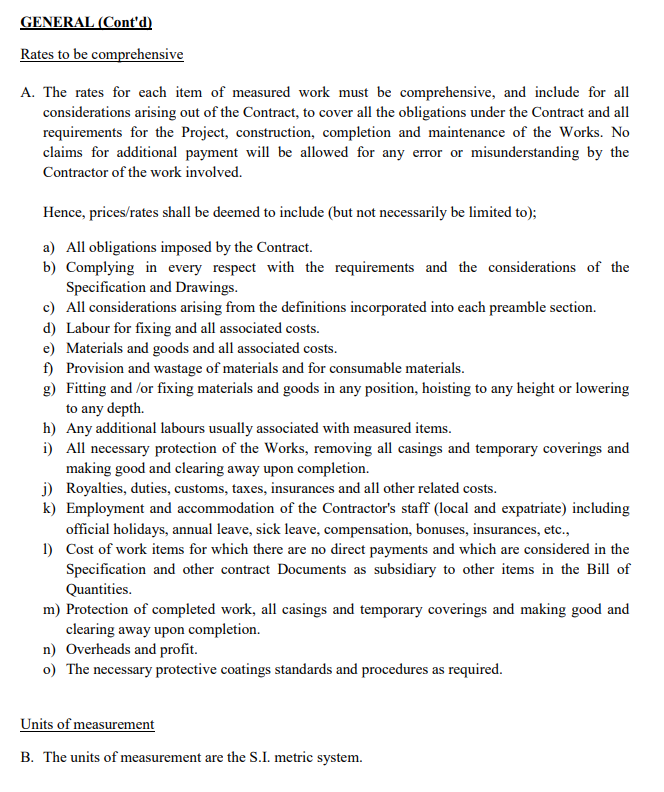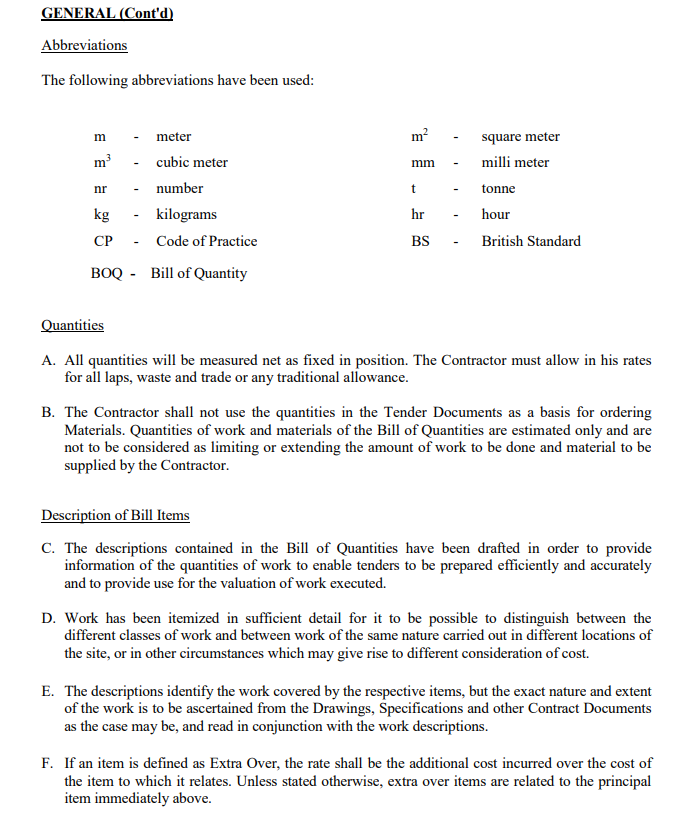Introduction
Have you ever tried assembling a piece of furniture without reading the instructions? It can be quite a frustrating experience, right? Well, the same applies to the construction industry. Without proper guidelines and explanations, misunderstandings and disputes can arise, leading to delays, cost overruns, and headaches for all parties involved. That’s where preambles in quantity surveying come into play. In this article, we’ll explore the importance of preambles and delve into the rate breakdown of the Bill of Quantities (BOQ), uncovering their significance in the construction realm.
What are Preambles in Quantity Surveying?
Imagine a contract, a specification, or a bill of quantities as a complex puzzle, with numerous pieces that need to fit together seamlessly. Preambles act as the glue that holds everything in place, providing an explanation of the document and aiding in its interpretation. They serve as a preamble to the main body of the document, offering crucial context and essential information. Think of them as the opening chapter of a book, setting the stage for what’s to come.
Elements of a Preamble
A well-crafted preamble encompasses several key elements that contribute to its effectiveness. These elements may include:
- Description of the Parties: The preamble introduces the parties involved in the contract, allowing for a clear understanding of their roles and responsibilities.
- Competence: It may highlight the competence or lack thereof of the parties, establishing a standard for the expected quality of goods or services and the level of support required.
- Background: Providing a background to the document helps stakeholders grasp the underlying context and purpose of the project.
- Summary of Negotiations: A summary of the negotiations outlines the key points and agreements reached, ensuring that all parties are on the same page.
- Tendering Procedures: This section may outline the procedures followed during the tendering process, shedding light on how the contract was awarded.
- Project Objectives: The preamble can articulate the objectives of the project, providing a clear direction and vision for the work to be executed.
- Related Documents: It may reference other relevant documents or previous contracts, elucidating their relationship to the current document.
It’s worth noting that preambles should focus on conveying essential information and avoid duplicating rights or obligations that are better addressed in the main body of the document.
The Importance of Pricing Preambles
Now that we understand what preambles are, let’s delve into their importance in quantity surveying. Accurate pricing lies at the heart of any construction project, and preambles play a vital role in achieving this objective. They provide a comprehensive guideline for tenderers to develop precise and informed offers.
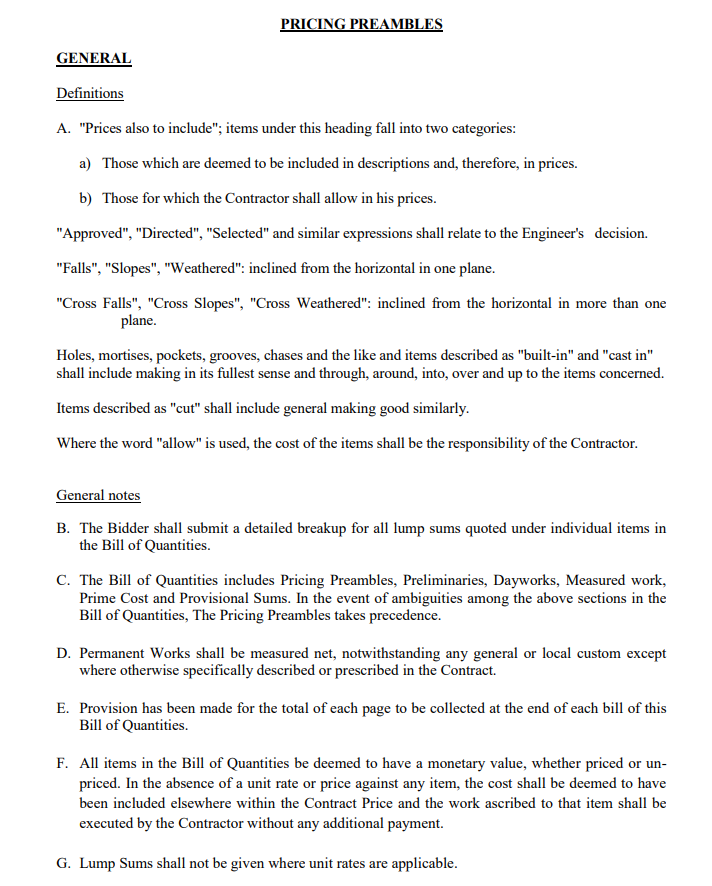
Guiding Tender Offers
Pricing preambles in the BOQ specify what costs should be included and excluded within the unit rates. They also outline the method of measurement adopted for each work item. This clarity ensures that tenderers have a consistent framework to base their calculations upon, reducing ambiguity and enabling accurate cost estimation.
By explicitly stating the inclusion and exclusion of costs, preambles guide tenderers in building up their rates, ensuring a fair and transparent bidding process. This not only benefits the tenderers by allowing them to submit competitive offers but also protects the interests of the project owner, who receives accurate and reliable tenders.
Enabling Document Interpretation
Construction projects involve a myriad of documents, each serving a specific purpose. Preambles aid in the interpretation of these documents, facilitating a comprehensive understanding of their content and intent. They act as a roadmap, helping stakeholders navigate the intricacies of the contract, specifications, and BOQ.
By providing context, clarifying procedures, and summarizing negotiations, preambles eliminate ambiguity and promote effective communication. They bridge the gap between technical jargon and practical application, ensuring that all parties involved share a common understanding of the project’s scope and requirements.
The Purpose of Rate Breakdown in BOQ Items
Imagine you’re a chef working on a signature dish. You meticulously select and measure each ingredient to achieve the perfect balance of flavors. Similarly, in construction, the rate breakdown of BOQ items serves as a recipe for calculating costs accurately and adjusting them when variations occur.
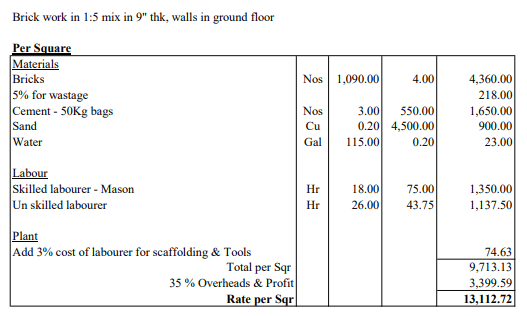
Sample Pricing Preample for Brick Work is as follows.
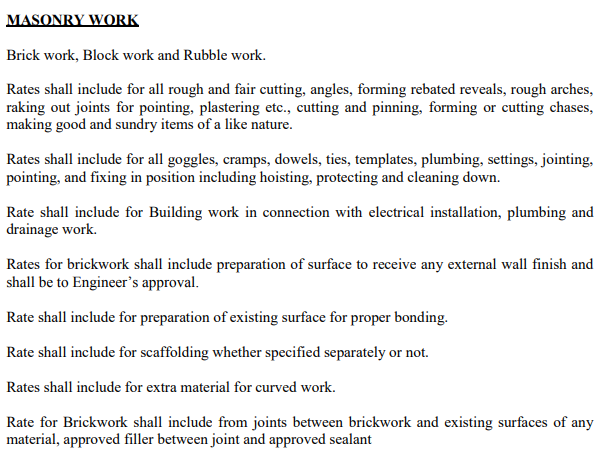
Building Flexibility into Rates
Contracts often require tenderers to provide rate breakdowns for their unit rates. While in practice, tenderers may not always provide these breakdowns at the tender stage, their purpose becomes evident during project progression. Rate breakdowns act as a foundation for creating new rates when variations arise.
Let’s say the contract specifies a particular type of cement for the concrete. However, during the project, the engineer decides to change the cement type. In such a scenario, the contractor may propose a higher rate to accommodate the cost difference. By referring to the original rate breakdown submitted by the contractor during the tender stage, the engineer can use it as a basis for deriving new rates, avoiding potential disputes.
Mitigating Disputes and Encouraging Consistency
By utilizing rate breakdowns, stakeholders can ensure consistency and prevent conflicts during project execution. These breakdowns provide a transparent and traceable mechanism for adjusting rates, taking into account variations in material costs, labor requirements, or technical specifications.
Without rate breakdowns, a change in a particular element of a work item could lead to disagreements over the adjusted rate. However, by relying on the original rate breakdowns, both the contractor and the engineer have a reference point to assess and negotiate changes, fostering a more harmonious and efficient construction process.
What is the Mark-Up?
Now that we’ve explored preambles and rate breakdowns, let’s shine a light on another essential aspect of construction pricing: the mark-up. Think of mark-up as the final seasoning that adds flavor and value to the dish. In construction, mark-up is the combination of overhead and profit that contractors factor into their pricing.
Understanding Overheads in Construction Projects
Overhead comprises two components:
- Site overhead
- Head office overhead
Site overhead encompasses costs directly related to the operation of a particular site but not directly attributable to the permanent works. These costs include temporary facilities, utility services, site offices and equipment, permits, and salaries of supervisors.
On the other hand, head office overhead represents the cost of running the contractor’s central administration. It includes expenses such as office rent, utility bills, salaries of head office staff, and office supplies. While site overhead is more project-specific, head office overhead applies to the overall operations of the contractor.
Recovering Head Office Overhead
Recovering head office overhead requires a methodical approach. Typically, the total head office overhead for a given period is distributed proportionately among projects based on their value and duration. This ensures a fair allocation of costs and prevents individual projects from bearing an excessive burden of the head office expenses.
For instance, if a company has a total head office overhead of $10 million and simultaneously undertakes five projects of equal value, each project should contribute $2 million toward the recovery of head office overhead. As project values vary, the portion of head office overhead allocated to each project adjusts proportionately.
Recovering Site Office Overhead
Site office overhead is usually included in the Preliminary Bill, which forms part of the BOQ. The method of recovering site office overhead depends on the payment arrangement agreed upon in the contract, such as time-related items or cost-related items. If the Preliminary Bill does not include specific site office overhead items, the contractor should incorporate them within the unit rates.
Examples of site office overhead items commonly included in the Preliminary Bill are temporary facilities, utility services, site fences, and hoardings, expenses related to permits, and the salaries of supervisors. By accounting for site office overhead in the pricing, contractors ensure that the necessary resources and facilities are available on-site throughout the project’s duration.
The Role of Mark-Up
In the gross pricing method, overhead and profit (OHP) are included within the unit rates. This means that during the tender evaluation, the employer or engineer cannot directly identify the contractor’s overhead and profit percentage. Conversely, in the net pricing method, unit rates only comprise the direct cost of each item, with the contractor’s mark-up added separately, typically in the grand summary.
While the gross pricing method may obscure the exact breakdown of overhead and profit, the contract stipulates the specified mark-up percentage to address variations and provisional sum items. When valuing a work item using the actual direct cost, the previously specified mark-up percentage is applied on top of it, ensuring the inclusion of overhead and profit in the final price.
Common Misconceptions and Challenges
Like any complex process, preambles, rate breakdowns, and overhead recovery in construction can present challenges and misconceptions. Let’s address a few common ones and provide some clarity:
1. “Preambles are unnecessary and add complexity.”
On the contrary, preambles simplify the interpretation of construction documents and promote clarity among stakeholders. They set the stage for smooth project execution by establishing a common understanding of key elements.
2. “Rate breakdowns are time-consuming and not practical.”
While providing rate breakdowns may require additional effort from tenderers, their practical application during project variations helps avoid disputes and maintain consistency in cost calculations.
3. “Overhead recovery is arbitrary and unfair.”
By distributing head office overhead proportionately among projects based on value and duration, fairness and equity are achieved. This approach ensures that no single project shoulders an excessive burden of the contractor’s central administration costs.
4. “Including site office overhead in the unit rates is redundant.”
While some site office overhead costs may be included in the Preliminary Bill, others may need to be accounted for within the unit rates to reflect the specific requirements of the project. This ensures accurate cost estimation and resource allocation.
5. “Mark-up is purely a profit margin.”
Mark-up includes both overhead and profit. It is the mechanism that accounts for the necessary costs of running the contractor’s operations and ensures a reasonable return on investment.
Tips for Effective Utilization
To maximize the benefits of preambles, rate breakdowns, and overhead recovery, quantity surveyors and contractors can follow these practical tips:
- Thoroughly review and understand preambles: Familiarize yourself with the preambles in relevant documents to grasp the project’s context and specific requirements.
- Clearly communicate pricing guidelines: Ensure that tenderers have a comprehensive understanding of the pricing preambles and any specific instructions regarding rate breakdowns.
- Document rate breakdowns: Even if not explicitly required at the tender stage, maintain a comprehensive record of rate breakdowns to serve as a reference during project variations.
- Regularly review and update overhead recovery methods: As project values and durations change, reassess the allocation of head office overhead to maintain fairness and accuracy.
- Collaborate and seek clarification: Foster open communication between stakeholders, including quantity surveyors, contractors, and project owners, to address any concerns or ambiguities related to preambles, rate breakdowns, or overhead recovery.
Conclusion
In the intricate world of construction, where precision and clarity are paramount, preambles and rate breakdowns in quantity surveying play a crucial role. Preambles provide essential context and guidelines for document interpretation, ensuring a common understanding among stakeholders. Rate breakdowns facilitate accurate cost estimation and enable adjustments during project variations. Meanwhile, overhead recovery methods, including mark-up, help contractors recover their necessary costs while generating a reasonable profit.
By embracing these practices and understanding their significance, professionals in the construction industry can promote transparency, avoid disputes, and achieve successful project outcomes.

